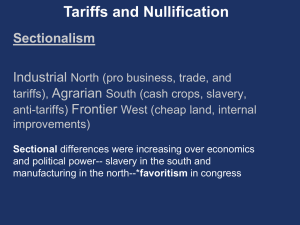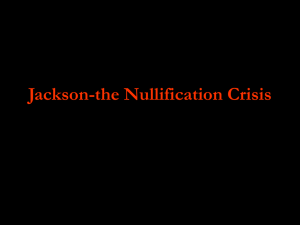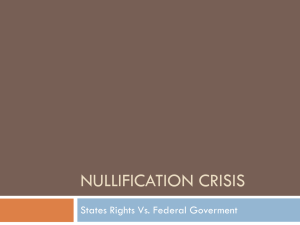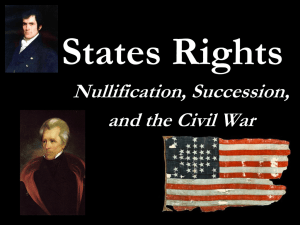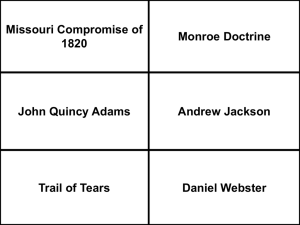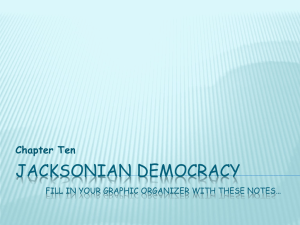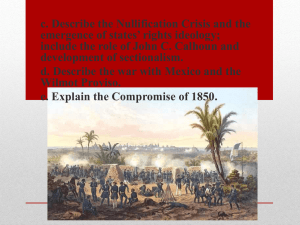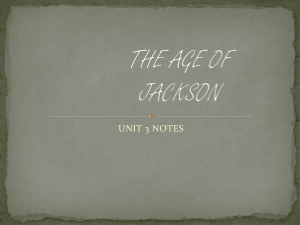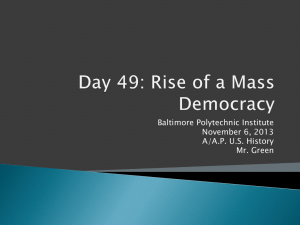The Nullification Crisis
advertisement
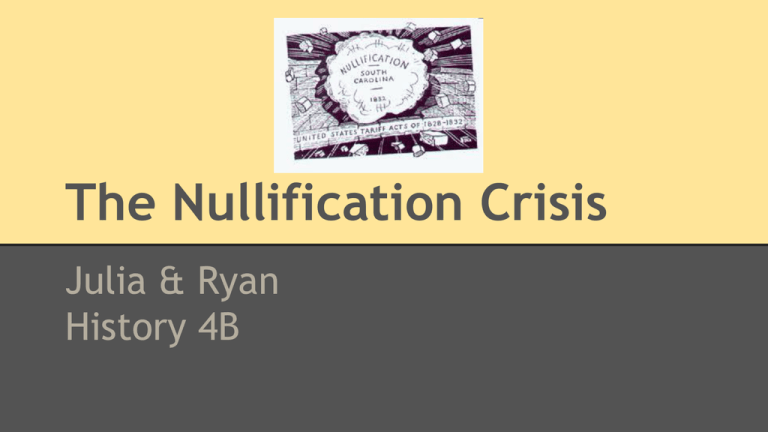
The Nullification Crisis Julia & Ryan History 4B Context ❖ From 1828 to 1834 ❖ Caused mainly by an economic downturn during the 1820’s. ❖ Affected mainly South Carolina ❖ President Andrew Jackson ❖ Two Crises ➢ Tariff of 1828 ➢ Compromise Tariff of 1832 Tariff of 1828 ❖ Known as the Tariff of Abomination. ❖ Approved by President John Adams on May 19,1828. ❖ Was to protect Northern and Western agricultural products from competition of foreign imports. ❖ The resulting tax on foreign goods rose the cost of living in the South. ❖ Cut into the profits of New England’s industrialists. Vice President Calhoun ❖ Supported the Tariff of 1816 but changed his position if he was to have a political future in South Carolina ❖ Anonymously penned the South Carolina Exposition and Protest, articulation the doctrine of nullification. ❖ Claimed that the federal import duties were actually a tax on the Southern planters ❖ Throughout his vice presidency Calhoun found that he was politically isolated from national affairs under President Jackson. ❖ December 28,1832 he resigned as vice president. Southern ❖ Linked their opposition of the tariff to a proslavery position ❖ Argued that the North intended to interfere with the institution of slavery by impoverishing the South. ❖ After Calhoun resigned his leitenutes from South carolina formed the States Rights and Free Trade Party to implement nullification. ❖ Upon Nullification South Carolina found itself isolated from the nation. ❖ Nullification crystallized South Carolina’s early ideological commitment to slavery and southern nationalism. Northern ❖ Northern States stood to profit greatly from the tariff. ❖ “Their object in the tariff is to keep down foreign competition, in order to obtain a monopoly of the domestic market ….” (Calhoun). ❖ In response to the Nullification Crisis in 1828 Congress nullified the law in South Carolina. Then president Jackson signed the Compromised Tariff of 1832. Jackson Nullification If video doesn’t play: https://www.youtube.com/watch?v=TK8PHLLdO2k President Jackson ❖ Tariff passed before ❖ Valued the Union ❖ Issued Nullification Proclamation ❖ Proposed Force Bill Force Bill of 1833 ❖ “Bloody Bill” ❖ Developed by Congress ❖ Gave power to enforce law Compromise ❖ Tariff of 1832 failed to pass ❖ Tariff of 1833 (Clay’s Compromise) ➢ Nullified Force Bill ➢ Gradually decreased Tariff ❖ Not liked by Southerners Southern Media Cartoon drawn during the nullification controversy showing the manufacturing North getting fat at Southern expense. Credit: Library of Congress, Washington, D.C. Crisis to War ❖ South Carolina willing to leave ❖ More political tension and division Works Cited Aboukhadijeh, Feross. "Nullification Crisis" StudyNotes.org. StudyNotes, Inc., 17 Nov. 2012. Web. 07 Sep. 2014. "The Tariff of Abominations | US House of Representatives: History, Art & Archives." The Tariff of Abominations. N.p., n.d. Web. 07 Sept. 2014. "Calhoun Resigns Vice Presidency." This Day in History. History.com, n.d. Web. 7 Sept. 2014. "The South Carolina Nullification Controversy." Ushistory.org. Independence Hall Association, n.d. Web. 07 Sept. 2014. "South Carolina Sesquicentennial History & Education - Nullification Crisis of 1828 to 1834." South Carolina Sesquicentennial History & Education - Nullification Crisis of 1828 to 1834. The South Carolina Encyclopedia, n.d. Web. 07 Sept. 2014. Calson, Cody K. "This Week in History: John C. Calhoun and the Nullification Crisis." DeseretNews.com. N.p., 17 Dec. 2012. Web. 07 Sept. 2014. Hodge, Cody. "The Nullification Crisis as a Cause of the Civil War." The Nullification Crisis as a Cause of the Civil War. Humanities 360, 23 July 2009. Web. 07 Sept. 2014. "Jackson Issues Nullification Proclamation." American President: American President. University of Virginia, n.d. Web. 07 Sept. 2014. “Jackson Nullification." YouTube. YouTube, n.d. Web. 07 Sept. 2014.
